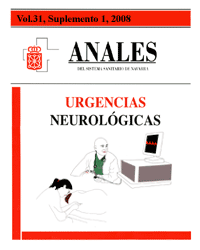Nuevas perspectivas en el manejo de la hemorragia intracraneal
Palabras clave:
Hematoma cerebral, Factor VII, Hipertensión arterial, Angiopatía amiloide, CoagulaciónResumen
La hemorragia cerebral se produce por la ruptura espontánea de un vaso intracraneal. Representa aproximadamente el 15% de todos los ictus, siendo la entidad que asocia una mayor morbimortalidad. De entre todos los predictores de mal pronóstico descritos, el más determinante es el volumen inicial del sangrado. Diversos trabajos muestran como, a diferencia de lo que se creía hasta no hace mucho tiempo, este sangrado no se autolimita en los primeros minutos, sino que progresa en hasta un 38% de casos, produciendo un deterioro significativo. Por lo tanto, uno de los objetivos prioritarios en el tratamiento de la hemorragia cerebral debería de ser, en primer lugar, la detección precoz de aquellos pacientes que presentan un mayor riesgo de presentar un crecimiento precoz de la hemorragia y en segundo lugar, la actuación precoz sobre aquellos factores que facilitan este crecimiento. En este trabajo revisamos los últimos hallazgos en la fisiopatología del crecimiento precoz y analizamos la evidencia disponible respecto a los nuevos tratamientos que, como el factor VII recombinante, tienen como objeto la reducción del volumen del sangrado.Descargas
Descargas
Publicado
Cómo citar
Número
Sección
Licencia
La revista Anales del Sistema Sanitario de Navarra es publicada por el Departamento de Salud del Gobierno de Navarra (España), quien conserva los derechos patrimoniales (copyright ) sobre el artículo publicado y favorece y permite la difusión del mismo bajo licencia Creative Commons Reconocimiento-CompartirIgual 4.0 Internacional (CC BY-SA 4.0). Esta licencia permite copiar, usar, difundir, transmitir y exponer públicamente el artículo, siempre que siempre que se cite la autoría y la publicación inicial en Anales del Sistema Sanitario de Navarra, y se distinga la existencia de esta licencia de uso.








